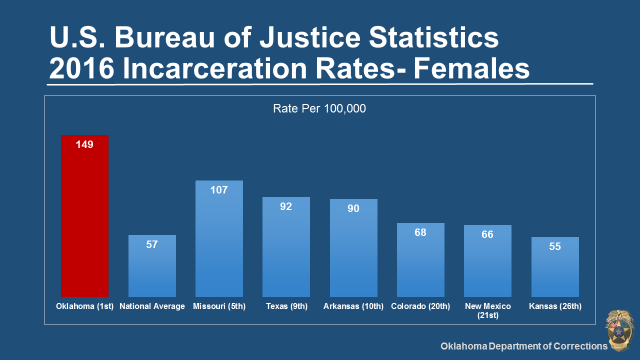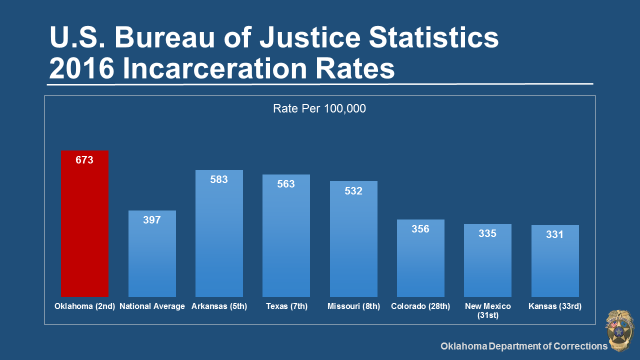Oklahoma No. 2 in the nation in overall incarceration in 2016; No. 1 in female incarceration
OKLAHOMA CITY – The Bureau of Justice Statistics has released its annual inmate census report detailing federal/state inmate populations and incarceration rates for 2016.
The report by BJS shows Oklahoma was second in the nation in overall incarceration rates for 2016 - with 673 people incarcerated per 100,000 residents. Louisiana, with 760 inmates per 100,000 residents, led the country - the national average was 397 per 100,000.
In 2016, Oklahoma continued to lead the nation in female incarceration – a dubious distinction the state has owned for more than 25 years.
“Unfortunately, none of this is a surprise,” said Joe M. Allbaugh, ODOC Director. “In fact, we expect Oklahoma’s incarceration rate to eventually be the country’s highest. This is due to the limited results of criminal justice reform in our state – and Louisiana’s successful reform efforts that will reduce how many people that state sends to prison.”
However, ODOC officials believe the BJS report may be misleading.
It claims Oklahoma had one of the largest declines in prison population of any state from 2015 to 2016, stating there were 1,700 fewer inmates in ODOC’s custody when comparing year ends (2015 = 28,114, 2016 = 26,486).
While the report accurately reflects the state’s prison population at year end, it does not account for inmates sentenced to prison and awaiting transfer to an ODOC facility.
The chart below reflects ODOC’s inmate count for the last working day of each calendar year. Using this data, prisoners decreased 545 from December 2015 to 2016 and 197 from December 2016 to 2017.
Those changes are far less dramatic than those the BJS reports – and are in fact negligible when one considers that there were 62,355 inmates and offenders in ODOC’s system and waiting to come in Friday morning.

When we add in female inmates awaiting ODOC reception, the number has actually increased since year-end 2015.

How Oklahoma compares at a glance
The first table below shows how Oklahoma’s female incarceration rate compares to the national average and contiguous states. The second table shows how Oklahoma’s overall incarceration rate compares to the national average and contiguous states.


Justice Reform
If Oklahoma had been at the national average at the end of 2016, its prison population would have been 15,851, or 11,020 fewer inmates.
The legislature has not approved any of the Governor’s Task Force recent recommendations that would have significantly impacted prison population growth.
Additionally, even if all of reforms of the last session had passed as written, they would not have addressed the overcrowding within ODOC facilities.
As of Friday morning, state prisons were at 112 percent of capacity.
Population expected to grow
A recent estimate by the Crime and Justice Institute indicates ODOC’s inmate population will grow 25 percent by 2026.
To meet these needs and others, the agency has requested $1.53 in funding from the legislature for Fiscal Year 2019 – a more than $1 billion increase over its current appropriation of $485 million.
In addition to more money for medical treatment, programs and IT needs, ODOC’s request includes more than $813 million for two new medium-security prisons, $107 million in repairs to crumbling facilities, and $10 million in across-the-board raises.
The budget request, which appropriate legislative committees will begin hearing on Tuesday, is similar to the agency’s $1.6 billion request for FY 2018.
The federal study can be found here.
###
Media Contact:
Matt Elliott, Communications Director
matthew.elliott@doc.ok.gov
(405) 425-2520
(405) 435-9173


